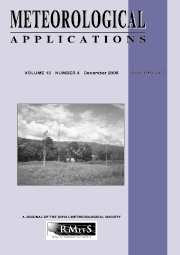Crossref Citations
This article has been cited by the following publications. This list is generated based on data provided by
Crossref.
Sansom, John
and
Gray, Warren R.
2002.
The Optimization and Calibration of a Rain Intensity Gauge.
Journal of Atmospheric and Oceanic Technology,
Vol. 19,
Issue. 1,
p.
3.
Lewis, H. W.
and
Harrison, D. L.
2007.
Assessment of radar data quality in upland catchments.
Meteorological Applications,
Vol. 14,
Issue. 4,
p.
441.
Ferranti, Emma Jayne Sakamoto
Whyatt, James Duncan
and
Timmis, Roger James
2009.
Development and application of topographic descriptors for conditional analysis of rainfall.
Atmospheric Science Letters,
Vol. 10,
Issue. 3,
p.
177.
Crochet, Philippe
2009.
Enhancing radar estimates of precipitation over complex terrain using information derived from an orographic precipitation model.
Journal of Hydrology,
Vol. 377,
Issue. 3-4,
p.
417.
Villarini, Gabriele
and
Krajewski, Witold F.
2010.
Review of the Different Sources of Uncertainty in Single Polarization Radar-Based Estimates of Rainfall.
Surveys in Geophysics,
Vol. 31,
Issue. 1,
p.
107.
Foresti, L.
Kanevski, M.
and
Pozdnoukhov, A.
2011.
Data-driven exploration of orographic enhancement of precipitation.
Advances in Science and Research,
Vol. 6,
Issue. 1,
p.
129.
Foresti, Loris
and
Pozdnoukhov, Alexei
2012.
Exploration of alpine orographic precipitation patterns with radar image processing and clustering techniques.
Meteorological Applications,
Vol. 19,
Issue. 4,
p.
407.
Foresti, Loris
Kanevski, Mikhail
and
Pozdnoukhov, Alexei
2012.
Kernel-Based Mapping of Orographic Rainfall Enhancement in the Swiss Alps as Detected by Weather Radar.
IEEE Transactions on Geoscience and Remote Sensing,
Vol. 50,
Issue. 8,
p.
2954.
Rössler, O.
Froidevaux, P.
Börst, U.
Rickli, R.
Martius, O.
and
Weingartner, R.
2014.
Retrospective analysis of a nonforecasted rain-on-snow flood in the Alps – a matter of model limitations or unpredictable nature?.
Hydrology and Earth System Sciences,
Vol. 18,
Issue. 6,
p.
2265.
Foresti, Loris
Panziera, Luca
Mandapaka, Pradeep V.
Germann, Urs
and
Seed, Alan
2015.
Retrieval of analogue radar images for ensemble nowcasting of orographic rainfall.
Meteorological Applications,
Vol. 22,
Issue. 2,
p.
141.
Rodrigo-Comino, Jesús
2021.
Precipitation.
p.
1.
Chakraborty, Swastika
Verma, Pooja
Paudel, Bishal
and
Das, Saurabh
2022.
Modeling of Ka-band slant path rain attenuation for hilly tropical region.
Advances in Space Research,
Vol. 70,
Issue. 3,
p.
601.
Germann, Urs
Boscacci, Marco
Clementi, Lorenzo
Gabella, Marco
Hering, Alessandro
Sartori, Maurizio
Sideris, Ioannis V.
and
Calpini, Bertrand
2022.
Weather Radar in Complex Orography.
Remote Sensing,
Vol. 14,
Issue. 3,
p.
503.
Hua, Ge
Li, Hongyi
and
Leung, L. Ruby
2025.
Nonlinear behavior of urban flood peaks in the U.S. Mid-Atlantic region.
Journal of Hydroinformatics,
Vol. 27,
Issue. 10,
p.
1493.
Chakraborty, Swastika
Mondal, Sumon Kumar
Shukla, Bipasha Paul
and
Das, Saurabh
2025.
Nowcasting of rain with Doppler weather radar – A comparative strategy for complex orography.
Journal of Earth System Science,
Vol. 134,
Issue. 4,

